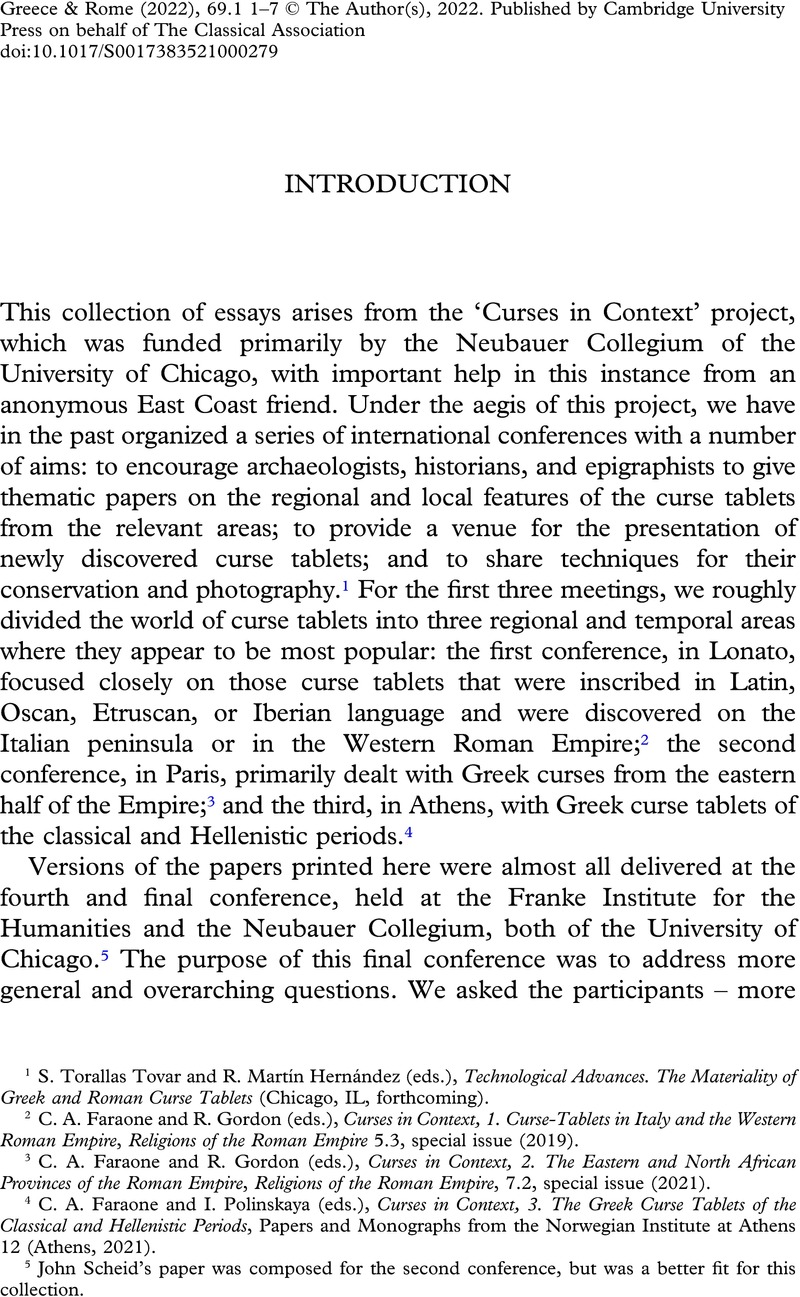No CrossRef data available.
Article contents
INTRODUCTION
Published online by Cambridge University Press: 07 March 2022
Abstract

- Type
- Introduction
- Information
- Copyright
- Copyright © The Author(s), 2022. Published by Cambridge University Press on behalf of The Classical Association
References
1 S. Torallas Tovar and R. Martín Hernández (eds.), Technological Advances. The Materiality of Greek and Roman Curse Tablets (Chicago, IL, forthcoming).
2 C. A. Faraone and R. Gordon (eds.), Curses in Context, 1. Curse-Tablets in Italy and the Western Roman Empire, Religions of the Roman Empire 5.3, special issue (2019).
3 C. A. Faraone and R. Gordon (eds.), Curses in Context, 2. The Eastern and North African Provinces of the Roman Empire, Religions of the Roman Empire, 7.2, special issue (2021).
4 Faraone, C. A. and Polinskaya, I. (eds.), Curses in Context, 3. The Greek Curse Tablets of the Classical and Hellenistic Periods, Papers and Monographs from the Norwegian Institute at Athens 12 (Athens, 2021)Google Scholar.
5 John Scheid's paper was composed for the second conference, but was a better fit for this collection.
6 The speech acts found on these binding spells include the performative ‘I bind so-and-so!’, the wish ‘May so-and-so be bound!’, and the prayer, to a usually chthonic deity, ‘You, O Hermes, bind so-and-so!’. See C. A. Faraone, ‘The Agonistic Context of Early Greek Binding Spells’, in C. A. Faraone and D. Obbink (eds.), Magika Hiera. Ancient Greek Magic and Religion (Oxford, 1991), 3–32; C. A. Faraone, ‘The Typical and the Outlier in Ancient Greek Cursing: Prayers for Justice, Erotic Curses, and Other Important Categories’, in K. Beerden and F. G. Naerebout (eds.), Coping with Versnel. The Contribution of Henk S. Versnel to the Study of Ancient Religion (Leiden, forthcoming).
7 H. S. Versnel, ‘Beyond Cursing’, in Faraone and Obbink (n. 6). These tablets are often publicly displayed in sanctuaries, name the petitioner, and aim at the divine punishment of the alleged perpetrators or at the return of stolen property.
8 See C. A. Faraone, ‘Aeschylus’ Hymnos Desmios (Eum. 306) and Attic Judicial Curse Tablets’, JHS 105 (1985), 150–4; and C. A. Faraone, ‘An Accusation of Magic in Classical Athens (Ar. Wasps 946–48)’, TAPA 119 (1989), 149–61. The latter discusses accusations that curse tablets were used to bind the talented orator Thucydides, the son of Melesias, in a high-profile political trial of the 440s bce.
9 Historically there has been a problem with the precise terminology to be used in discussing these curse tablets. In all of the Curses in Context volumes we have followed the precedent of using ‘curse tablet’ as the genus of all curses inscribed on lead, and then the following terms for the two major species or subdivisions: (i) katadesmos, defixio, or ‘binding curse’ to describe those used to restrain rivals or enemies in the future; and (ii) ‘prayer for justice’ for those used to punish malefactors for past offences. The equation defixio = ‘curse tablet’ is an old one, enshrined by the two giants in the field, Wünsch and Audollent, who published their corpora in Latin and naturally used a convenient Latin term. In the end, however, this was an unfortunate choice, because the etymology of defixio (i.e. a curse that ‘nails down’) makes it suitable for those curses that are indeed rolled up, nailed, and aim at ‘restraint’, but confusing when applied to other curses, where revenge or restitution of a stolen object is the goal (for example, the Cnidian curse tablets in Audollent's collection). For the sea change in thinking about this problem, see the introduction to David Jordan's survey ‘New Greek Curse Tablets (1985–2000)’, GRBS 41 (2000), 5–46, where he explains his change of mind and decision to call the wider category ‘curse tablets’ rather than defixiones.
10 D. R. Jordan, ‘A Survey of Greek Defixiones Not Included in the Special Corpora’, GRBS 26 (1985), 151–97; Jordan (n. 9); John Gager, Curse Tablets and Binding Spells from the Ancient World (Oxford, 1992).
11 See the appendix to J. Curbera, ‘A Tablet Without Context: Wünsch's “Tabella Melia”’, in Faraone and Polinskaya (n. 4); for parallels, see also Faraone, C. A., ‘Binding and Burying the Forces of Evil: The Defensive Use of “Voodoo Dolls” in Ancient Greece’, ClAnt 10 (1991), 165–205Google Scholar; Faraone, C. A., ‘Animals-Effigies in Ancient Curses: The Role of Gender, Age, and Natural Behavior in Their Selection’, MediterrAnt 22 (2019), 289–315Google Scholar, esp. 311–12.
12 See I. Polinskaya, ‘Inscribed Ceramic Bowls and Other Curses from Classical and Hellenistic Olbia’, in Faraone and Polinskaya (n. 4).
13 Kerameikos: J. Stroszeck, ‘The Archaeological Contexts of the Curse Tablets in the Athenian Kerameikos’, in Faraone and Polinskaya (n. 4). Himera: Vassallo, S., ‘Le necropoli di Himera: gli spazi, le architetture funerarie, i segni della memoria’, in Adroit, S. and Graells i Fabregat, R. (eds.), Arquitecturas funerarias y memoria. La gestión de las necrópolis en Europa occidental (ss. X–III a.C.) (Madrid, 2017), 167–80Google Scholar. Agora: Lamont, J. L., ‘The Curious Case of the Cursed Chicken: A New Binding Ritual from the Athenian Agora’, Hesperia 90 (2021), 79–113CrossRefGoogle Scholar; and J. L. Lamont, ‘Cursing in Context: Athenian Pyre Curses’, in Faraone and Polinskaya (n. 4).
14 For recent bibliography, see the essays of Gordon, Scheid, and Sánchez Natalías in this volume.



